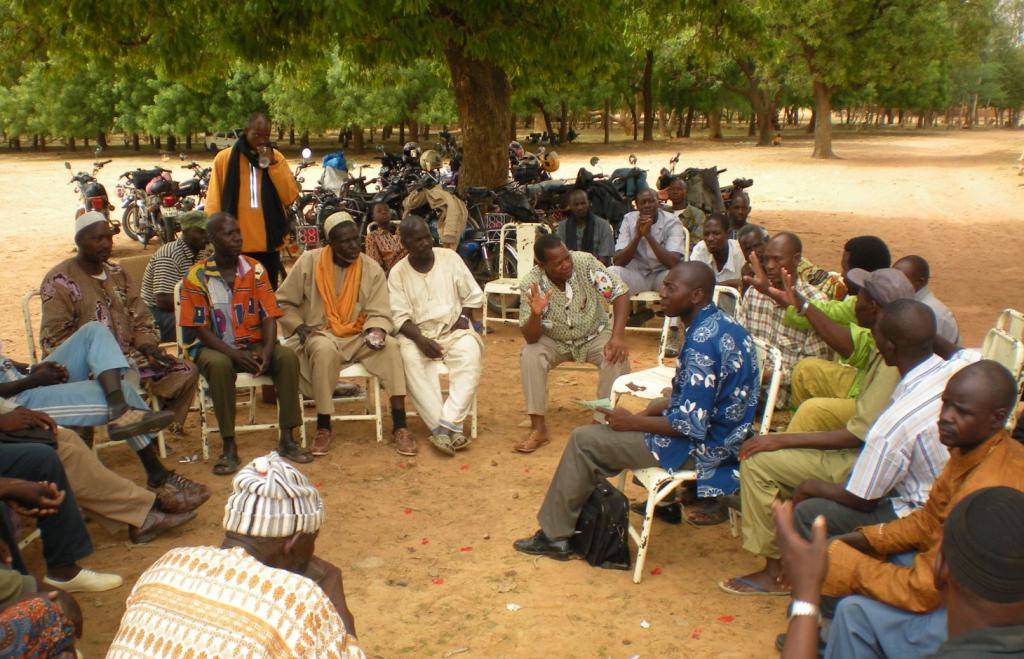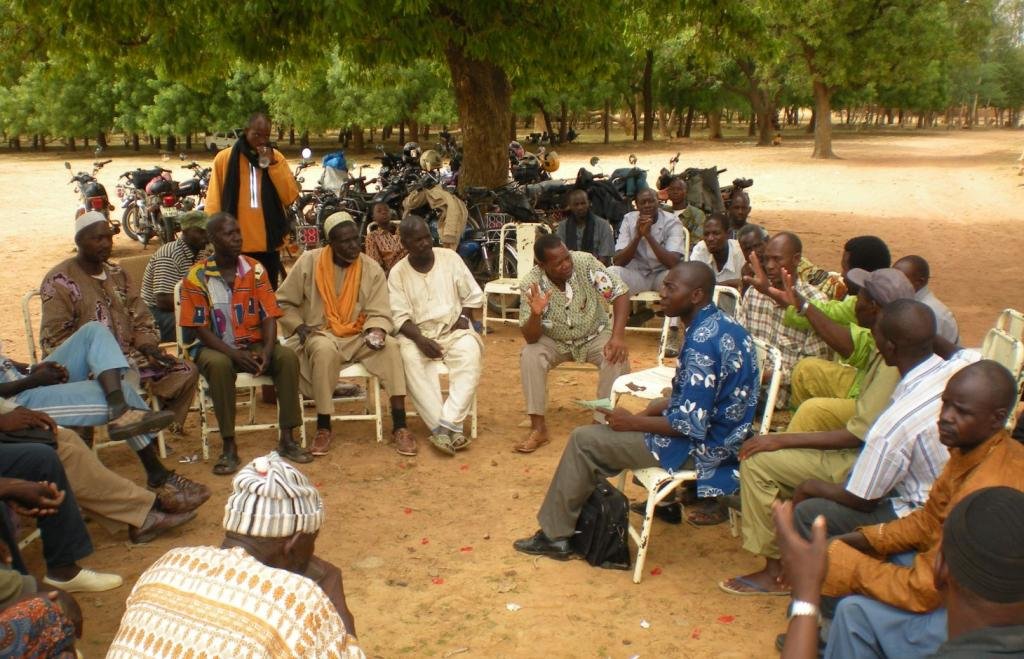Local agreements on the management of small-scale irrigation facilities [มาลี]
- ผู้สร้างสรรค์:
- การอัพเดท:
- ผู้รวบรวม: Dieter Nill
- ผู้เรียบเรียง: –
- ผู้ตรวจสอบ: Laura Ebneter
Convention locale pour la gestion des aménagements hydro-agricoles
approaches_2504 - มาลี
ดูส่วนย่อย
ขยายทั้งหมด ย่อทั้งหมด1. ข้อมูลทั่วไป
1.2 รายละเอียดที่ติดต่อได้ของผู้รวบรวมและองค์กรที่เกี่ยวข้องในการประเมินและการจัดเตรียมทำเอกสารของแนวทาง
ผู้เชี่ยวชาญ SLM:
Mushinzimana Godihald
godihald.mushinzimana@giz.de
Deutsche Gesellschaft für Internationale Zusammenarbeit (GIZ)
มาลี
ชื่อของโครงการซึ่งอำนวยความสะดวกในการทำเอกสารหรือการประเมินแนวทาง (ถ้าเกี่ยวข้อง)
Programme for Territorial Communities, Mali (PACT)ชื่อของโครงการซึ่งอำนวยความสะดวกในการทำเอกสารหรือการประเมินแนวทาง (ถ้าเกี่ยวข้อง)
Deutsche Gesellschaft für Internationale Zusammenarbeit (GIZ) GmbH (GIZ) - เยอรมนี1.3 เงื่อนไขที่เกี่ยวข้องกับการใช้ข้อมูลที่ได้บันทึกไว้ผ่านทาง WOCAT
วันที่เก็บรวบรวมข้อมูล (ภาคสนาม):
01/07/2012
ผู้รวบรวมและวิทยากรหลักยอมรับเงื่อนไขเกี่ยวกับการใช้ข้อมูลที่ถูกบันทึกผ่านทาง WOCAT:
ใช่
2. คำอธิบายของแนวทาง SLM
2.1 การอธิบายแบบสั้น ๆ ของแนวทาง
Local agreements aim to prevent and consensually manage conflicts on a site and to manage natural resources to ensure they are used rationally and sustainably.
2.2 การอธิบายอย่างละเอียดของแนวทาง
การอธิบายอย่างละเอียดของแนวทาง:
A local agreement is a mutual agreement covering the ways in which shared natural resources are exploited in order to ensure their fair and sustainable use. As the national methodological guide puts it: ‘All agreements, written or otherwise, between two or more local actors and particularly social groups (socio-professional groups, village associations or communities, or factions), technical services and NGOs set the rules for accessing and using the resources in a way which ensures their conservation and their responsible and sustainable exploitation’.
The local agreement is the fruit of a series of consultation and negotiation forums involving local farmers and managers of a shared natural resource and is delivered with the support of local authorities and their technical services. These consultation and negotiation forums make it possible for all the actors involved to evaluate the status of the resource, identify problems and put forward possible solutions. The forums create a climate of trust among user groups who, despite the difficulties of living side-by-side, remain willing to come together around the same table. The management ideas resulting from the discussions and negotiations are laid down in the form of consensual management rules, collectively called the ‘local agreement’.
Stages of implementation: 1)Information and identification of key actors in the process of drawing up a local agreement. As it is not possible for everyone to participate in the consultation exercise, the process is based on delegation. 2)Natural resource diagnostic exercise: first taking a snapshot of the current state of the resource using tools like resource maps, Venn diagrams and matrices categorizing producers by product. Next, problems arising from resource exploitation and management, and possible solutions to these problems, are identified. 3)The results are fed back to actors who have not been involved in the diagnostic process in order to gather their inputs. 4)Drawing up the draft local agreement: analysing reaction to the diagnostic feedback in order to (i) take on board the most relevant inputs and (ii) flesh out and refine the ideas for regulatory solutions (concrete management rules and their associated sanctions – this constitutes the ‘draft local agreement’) without losing sight of the national legislation relating to the resource. It is during this stage that the mechanism for monitoring the implementation of the agreement is developed. 5)Feedback and validation of the draft: in order to refine the terms of the draft local agreement, the select committee instituted by all those participating in the process feeds back the results of its work and then debates them. Once the terms are agreed by all parties, it is considered validated. 6)The draft local agreement is signed by the local managers of the resource and is then considered by the territorial community and approved by the supervisory authority, where required. Hardcopies of the signed agreement are subsequently given out to key actors and it is disseminated through discussions in general meetings and on local radio. 7)Monitoring bodies are set up to monitor local agreement implementation at the village and commune levels and to deliver training on the roles and responsibilities required at these levels. 8)Monitoring and evaluation is carried out with regard to the implementation of the local agreement and the functioning of bodies tasked with monitoring the implementation.
Involved actors: Territorial communities, farmers and managers of natural resources, technical services, financial support structure.
2.3 รูปภาพของแนวทาง
2.5 ประเทศ ภูมิภาค หรือสถานที่ตั้งที่ได้นำแนวทางไปใช้
ประเทศ:
มาลี
ภูมิภาค/รัฐ/จังหวัด: :
Mali
ข้อมูลเฉพาะเพิ่มเติมของสถานที่ตั้ง:
Sikasso, Mopti, Koulikoro, Timbuktu
2.6 วันที่เริ่มต้นและสิ้นสุดของแนวทาง
ระบุปีที่เริ่ม:
2004
2.7 ประเภทของแนวทาง
- ใช้โครงงานหรือแผนงานเป็นฐาน
2.8 เป้าหมายหรือวัตถุประสงค์หลักของแนวทาง
The Approach focused mainly on SLM with other activities
Agreements between different actors on the sustainable and fair use of shared natural resources, reduction of conflicts
The SLM Approach addressed the following problems: conflicts on and unsustainable use of natural resources
2.9 เงื่อนไขที่เอื้ออำนวยหรือเป็นอุปสรรคต่อการนำเทคโนโลยีภายใต้แนวทางนี้ไปปฏิบัติใช้
การจัดตั้งระดับองค์กร
- เป็นอุปสรรค
conflicts and missing agreement on sustainable use of natural resources
Treatment through the SLM Approach: A local agreement is a mutual agreement covering the ways in which shared natural resources are exploited in order to ensure their fair and sustainable use. All agreements between two or more local actors and particularly social groups (socio-professional groups, village associations or communities, or factions), technical services and NGOs set the rules for accessing and using the resources in a way which ensures their conservation and their responsible and sustainable exploitation’.
3. การมีส่วนร่วมและบทบาทของผู้มีส่วนได้ส่วนเสียที่เกี่ยวข้อง
3.1 ผู้มีส่วนได้ส่วนเสียที่เกี่ยวข้องในแนวทางนี้และบทบาท
- ผู้ใช้ที่ดินระดับท้องถิ่นหรือชุมชนระดับท้องถิ่น
- ผู้เชี่ยวชาญ SLM หรือที่ปรึกษาการเกษตร
- รัฐบาลแห่งชาติ (ผู้วางแผน ผู้ทำการตัดสินใจ)
- องค์การระหว่างประเทศ
3.2 การเกี่ยวข้องของผู้ใช้ที่ดินระดับท้องถิ่นหรือชุมชนระดับท้องถิ่นในช่วงต่างๆของแนวทาง
| ความเกี่ยวข้องของผู้ใช้ที่ดินระดับท้องถิ่นหรือชุมชนระดับท้องถิ่น | ระบุผู้ที่มีส่วนเกี่ยวข้องและอธิบายกิจกรรม | |
|---|---|---|
| การริเริ่มหรือการจูงใจ | ปฏิสัมพันธ์ | |
| การวางแผน | ปฏิสัมพันธ์ | |
| การดำเนินการ | ปฏิสัมพันธ์ | |
| การติดตามตรวจสอบหรือการประเมินผล | ปฏิสัมพันธ์ | |
| Research | ไม่ลงมือ |
3.4 การตัดสินใจเลือกใช้เทคโนโลยี SLM
ระบุผู้ที่ทำการตัดสินใจเลือกเทคโนโลยีมากกว่าหนึ่งวิธีไปปฏิบัติใช้:
- ผู้ใช้ที่ดินเป็นผู้ตัดสินใจหลัก โดยการสนับสนุนจากผู้เชี่ยวชาญ SLM
4. การสนับสนุนด้านเทคนิค การสร้างขีดความสามารถ และการจัดการด้านความรู้
4.1 การสร้างขีดความสามารถ / การอบรม
ได้มีการจัดอบรมให้แก่ผู้ใช้ที่ดินหรือผู้มีส่วนได้ส่วนเสียคนอื่น ๆ หรือไม่:
ใช่
ให้ระบุว่าใครเป็นผู้ได้รับการอบรม:
- ผู้ใช้ที่ดิน
รูปแบบการอบรม:
- จัดการประชุมสู่สาธารณชน
4.2 การบริการให้คำแนะนำ
ผู้ใช้ที่ดินมีการเข้าถึงการรับบริการให้คำปรึกษาหรือไม่:
ใช่
การอธิบาย/แสดงความคิดเห็น:
Advisory service is quite adequate to ensure the continuation of land conservation activities
4.3 การเสริมความแข็งแกร่งให้กับสถาบัน (การพัฒนาองค์กร)
สถาบันได้รับการจัดตั้งขึ้นมาหรือเสริมความแข็งแกร่งโดยแนวทางนี้หรือไม่:
- ใช่ ปานกลาง
ระบุระดับของสถาบันที่ได้รับการเสริมความแข็งแกร่งหรือจัดตั้งขึ้นมา:
- ท้องถิ่น
ระบุประเภทของการให้ความช่วยเหลือสนับสนุน:
- ด้านการเงิน
- การสร้างขีดความสามารถ / การอบรม
4.4 การติดตามตรวจสอบและประเมินผล
การติดตามตรวจสอบและประเมินผลเป็นส่วนหนึ่งของแนวทางหรือไม่:
ใช่
ความคิดเห็น:
technical aspects were ad hoc monitored by project staff, land users through observations;
socio-cultural aspects were ad hoc monitored by project staff, land users through observations;
management of Approach aspects were ad hoc monitored by project staff, land users through observations;
bio-physical aspects were ad hoc monitored by None through observations;
There were no changes in the Approach as a result of monitoring and evaluation;
There were no changes in the Technology as a result of monitoring and evaluation;
4.5 การวิจัย
การวิจัยเป็นส่วนหนึ่งของแนวทางหรือไม่:
ใช่
ระบุหัวข้อเรื่อง:
- สังคมวิทยา
- เศรษฐศาสตร์หรือการตลาด
- นิเวศวิทยา
- เทคโนโลยี
5. การสนับสนุนด้านการเงินและวัสดุอุปกรณ์
5.1 ระบุงบประมาณประจำปีสำหรับแนวทาง SLM นี้
ถ้าหากว่างบประมาณประจำปีไม่เป็นที่ทราบแน่นอน ให้ระบุช่วงลงไป:
- 2,000-10,000
แสดงความคิดเห็น (แหล่งของการระดมทุน ผู้บริจาคคนสำคัญ):
Approach costs were met by the following donors: international: 100.0%
5.2 การสนับสนุนด้านการเงิน / วัสดุอุปกรณ์ให้แก่ผู้ใช้ที่ดิน
ผู้ใช้ที่ดินได้รับการสนับสนุนด้านการเงิน / วัสดุอุปกรณ์ไปปฏิบัติใช้เทคโนโลยีหรือไม่:
ใช่
5.3 เงินสนับสนุนสำหรับปัจจัยนำเข้า (รวมถึงแรงงาน)
ถ้าแรงงานโดยผู้ใช้ที่ดินเป็นปัจจัยนำเข้าที่มีอยู่มากมาย ระบุด้วยว่าเนื่องจาก:
- สมัครใจ
6. การวิเคราะห์ผลกระทบและการสรุป
6.1 ผลกระทบของแนวทาง
ช่วยให้ผู้ใช้ที่ดินนำเอาเทคโนโลยี SLMไปใช้และบำรุงรักษาสภาพไว้ได้หรือไม่:
- ไม่ใช่
- ใช่ เล็กน้อย
- ใช่ ปานกลาง
- ใช่ อย่างมาก
All agreements, written or otherwise, between two or more local actors and particularly social groups (socio-professional groups, village associations or communities, or factions), technical services and NGOs set the rules for accessing and using the resources in a way which ensures their conservation and their responsible and sustainable exploitation.
ทำให้กลุ่มด้อยโอกาสมีอำนาจทางสังคมและเศรษฐกิจหรือไม่:
- ไม่ใช่
- ใช่ เล็กน้อย
- ใช่ ปานกลาง
- ใช่ อย่างมาก
The consultation and negotiation forums make it possible for all the actors involved to evaluate the status of the resource, identify problems and put forward possible solutions.
Did other land users / projects adopt the Approach?
- ไม่ใช่
- ใช่ เล็กน้อย
- ใช่ ปานกลาง
- ใช่ อย่างมาก
Implementation locations: Sikasso, Mopti, Koulikoro, Timbuktu and others. A local agreement for managing natural resources usually applies for between three to five years. At the end of this period, the agreement must be evaluated in order to take account of new developments. PACT has been using these local agreements since 2004.
Did the Approach lead to improved livelihoods / human well-being?
- ไม่ใช่
- ใช่ เล็กน้อย
- ใช่ ปานกลาง
- ใช่ อย่างมาก
The forums create a climate of trust among user groups who, despite the difficulties of living side-by-side, remain willing to come together around the same table.
Did the Approach help to alleviate poverty?
- ไม่ใช่
- ใช่ เล็กน้อย
- ใช่ ปานกลาง
- ใช่ อย่างมาก
6.2 แรงจูงใจหลักของผู้ใช้ที่ดินเพื่อที่จะนำ SLM ไปปฏิบัติใช้
- การผลิตที่เพิ่มขึ้น
- กำไร (ความสามารถ) อัตราส่วนค่าใช้จ่ายต่อผลประโยชน์ที่เพิ่มขึ้น
6.3 ความยั่งยืนของกิจกรรมของแนวทาง
ผู้ใช้ที่ดินสามารถทำให้สิ่งต่างๆ ที่ได้ปฏิบัติใช้โดยแนวทางนี้ยั่งยืนได้หรือไม่ (โดยไม่มีการสนับสนุนจากภายนอก):
- ใช่
ถ้าตอบว่าใช่ ให้อธิบายว่าอย่างไร :
A local agreement for managing natural resources usually applies for between three to five years. At the end of this period, the agreement must be evaluated in order to take account of new developments. PACT has been using these local agreements since 2004.
The sustainability of the local agreement depends on the level to which its terms are taken up by those who developed it and who are responsible for implementing it. It also depends on the relevance of the regulatory and technical solutions taken forward for resolving the major issues identified in the diagnostic process.
6.4 จุดแข็งและข้อได้เปรียบของแนวทาง
| จุดแข็ง / ข้อได้เปรียบของแนวทางในทัศนคติของผู้รวบรวมหรือวิทยากรหลัก |
|---|
| More rational and sustainable exploitation of resources |
| Fairer access to developed lands |
| Consultative management of the shared resource |
| Reduction and prevention of conflicts (How to sustain/ enhance this strength: The diagnostic process must reflect reality, as expressed by the beneficiaries themselves. During the diagnostic process, beneficiaries must be given guidance but must not be directly influenced. The solutions put forward must come from the beneficiaries. There must be continuity in terms of key actor representation. The results from consultation exercises must be fed back into the process. Local authorities, supervisory bodies and technical services must be involved. A set of technical measures must be implemented based on the results of the diagnostic process. These measures must reinforce the management rules.) |
| Local agreements on managing developed lands and facilities are drawn up for the majority of hydro-agricultural schemes (How to sustain/ enhance this strength: There must be a system in place to take action against those breaking the terms of the convention (committees and technical services)) |
6.5 จุดอ่อน / ข้อเสียเปรียบของแนวทางและวิธีในการแก้ไข
| จุดอ่อน / ข้อเสียเปรียบในทัศนคติของผู้รวบรวมหรือวิทยากรหลัก | สามารถแก้ไขปัญหาได้อย่างไร |
|---|---|
|
Getting remote farmers – such as those in localities outside the scope of the local agreement – to respect the rules laid down in the local agreement can be problematic. |
|
| Once the scheme starts developing lands (increasing yields), new conflicts can arise (jealousy) |
7. การอ้างอิงและการเชื่อมต่อ
7.1 วิธีการหรือแหล่งข้อมูล
- ไปเยี่ยมชมภาคสนาม การสำรวจพื้นที่ภาคสนาม
- การสัมภาษณ์กับผู้ใช้ที่ดิน
7.2 การอ้างอิงถึงสิ่งตีพิมพ์
ชื่อเรื่อง ผู้เขียน ปี ISBN:
Manual of Good Practices in Small Scale Irrigation in the Sahel. Experiences from Mali. Published by GIZ in 2014.
ช่องทางในการสืบค้น และราคา:
http://star-www.giz.de/starweb/giz/pub/servlet.starweb
ชื่อเรื่อง ผู้เขียน ปี ISBN:
Guide méthodologique national, élaboration d’une convention locale de gestion des ressources naturelles [National methodological guide – Drawing up a local agreement to manage natural resources], MEA (Ministry of Environment and Sanitation), June 2011
ชื่อเรื่อง ผู้เขียน ปี ISBN:
Full-cost accounting of local agreements, PACT, October 2006
ชื่อเรื่อง ผู้เขียน ปี ISBN:
www.pact-mali.org
ลิงก์และโมดูล
ขยายทั้งหมด ย่อทั้งหมดลิงก์
ไม่มีลิงก์
โมดูล
ไม่มีโมดูล



